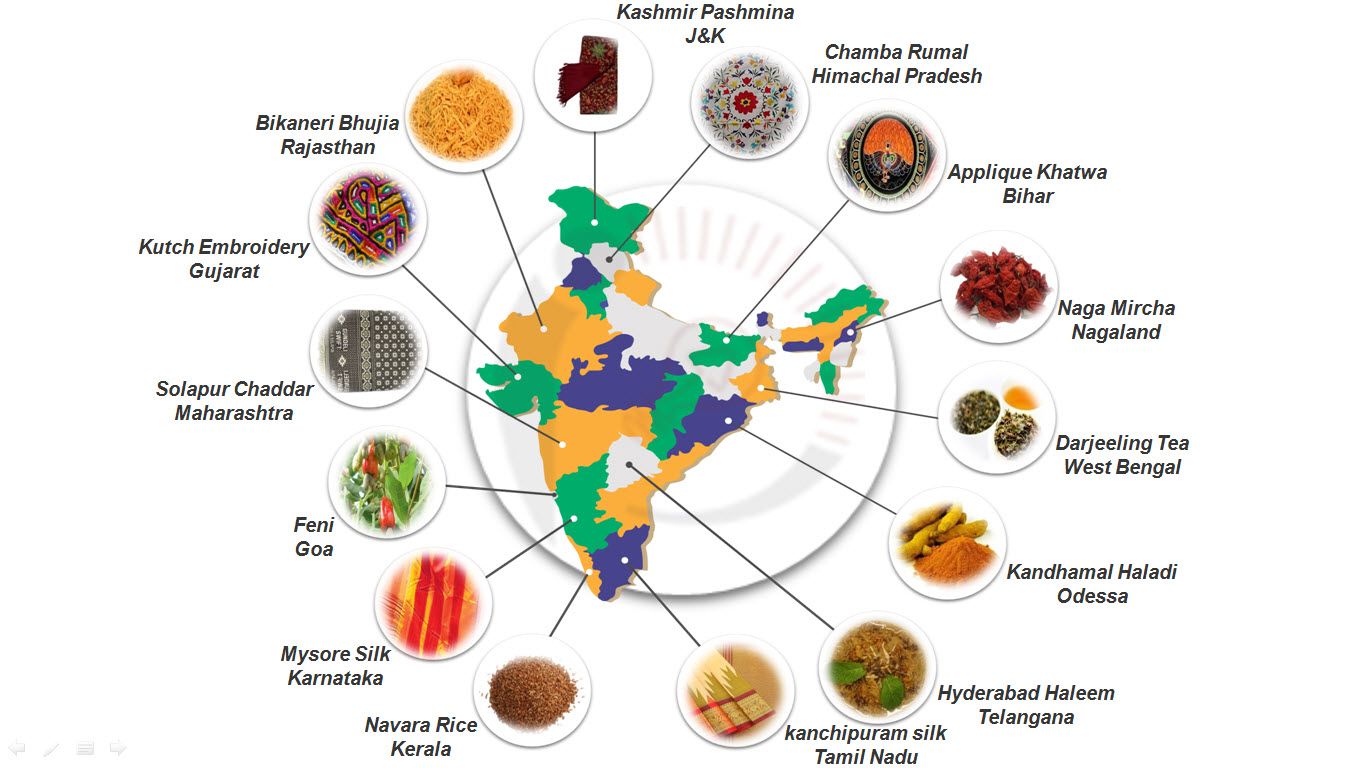Ensuring the legal protection of Geographical Indications and the safeguarding of cultural heritage under applicable intellectual property and cultural preservation laws.
Author: Jasmeet Makkar, Student of Bharati Vidyapeeth Deemed University, Delhi
INTRODUCTION
In India, Geographical Indications (GIs) have emerged as a vital instrument for the protection and promotion of regional products, as well as for the safeguarding of cultural heritage. A Geographical Indication is a sign used on goods that have a specific geographical origin and possess qualities, reputation, or characteristics inherent to that location. These distinctive labels serve as crucial intellectual property rights, preserving the reputation, quality, and uniqueness of goods tied to a particular region. GIs not only enable the protection of regional products from unauthorized use but also provide a robust legal defence against counterfeiting and misuse, which can undermine local economies, erode cultural heritage, and mislead consumers.
The legal framework for GIs in India is established under the *Geographical Indications of Goods (Registration and Protection) Act, 1999* (hereinafter referred to as the “GI Act”). This statute grants exclusive rights to producers from specific regions to use the GI tag on their products, thereby preventing unauthorized entities from exploiting these geographically-specific identifiers. The GI Act ensures that only legitimate producers and authorized users may market products with GI labels that correspond to particular regions, ensuring authenticity and upholding the integrity of regional products.
In addition to commercial protection, the legal significance of GIs extends to the preservation of cultural heritage and the promotion of regional socio-economic development. By safeguarding traditional knowledge, artisanal skills, and indigenous methods of production, GIs contribute to the conservation of cultural identity while providing economic benefits to local communities. The GI system thus functions as a dual mechanism, protecting both the intellectual property of regional producers and the cultural traditions embedded within those products.
The scope of GIs in India goes beyond mere commercial protection, reflecting a broader role in fostering sustainable development. Through the recognition and registration of GIs, local communities benefit from increased market access and visibility, while maintaining control over the use of their traditional knowledge. Moreover, GIs can incentivize responsible production practices, thereby promoting environmental sustainability and ethical commerce. Consequently, the legal framework surrounding GIs plays a pivotal role not only in intellectual property law but also in the broader objectives of cultural heritage preservation and regional development.
This research aims to contribute to the growing body of legal scholarship on the intersection of intellectual property rights, cultural preservation, and sustainable development in India. By analysing pertinent case laws, legal precedents, and the broader implications of GI protection, this study seeks to enhance the understanding of the legal consequences and practical challenges associated with the use of Geographical Indications in India. Through an examination of the evolving jurisprudence and policy framework, this research will provide a comprehensive analysis of the legal dimensions of GIs, addressing key issues such as the scope of protection, the role of enforcement mechanisms, and the implications for regional producers and consumers alike.
Furthermore, this study will explore the potential for strengthening the legal framework for GIs in India, considering both domestic and international perspectives. In particular, the growing trend of international recognition and protection of GIs will be examined, with a focus on India’s obligations under various trade agreements, including the Trade-Related Aspects of Intellectual Property Rights (TRIPS) Agreement. This comparative analysis will also assess India’s GI regime in light of global best practices and the evolving needs of regional producers, with the aim of ensuring that the GI system continues to serve as an effective tool for both commercial and cultural preservation in the years to come.
The legal protection of Geographical Indications in India offers far-reaching implications for regional development, cultural heritage preservation, and intellectual property rights enforcement. Through robust legal instruments and policies, GIs not only protect the interests of local producers but also contribute to the broader goals of sustainable development and cultural conservation. This research seeks to advance the legal discourse on GIs and their transformative potential in fostering a more inclusive and equitable framework for intellectual property and cultural heritage protection.
HISTORICAL BACKGROUND OF GEOGRAPHICAL INDICATION LAW IN INDIA.
Prior to 1999, India lacked a comprehensive legislative framework specifically addressing the protection of Geographical Indications (GIs). While India was a signatory to the Agreement on Trade-Related Aspects of Intellectual Property Rights (TRIPS), it did not enact any dedicated legal provisions for the protection of GIs until the passage of the Geographical Indications of Goods (Registration and Protection) Act, 1999 (hereinafter referred to as the “GI Act”).
A critical turning point in the recognition of the need for GI protection in India occurred in 1997, with the *Basmati* controversy. This dispute arose from the unauthorized use of the term “Basmati” to describe certain rice varieties, particularly in international markets. The issue highlighted concerns regarding the economic and reputational harm caused to the producers of authentic Basmati rice, who were primarily located in specific regions of India and Pakistan. The misuse of the term “Basmati” by foreign producers threatened the distinctiveness and authenticity of the product, thus endangering the livelihoods of farmers and producers associated with the genuine cultivation of Basmati rice. This controversy underscored the urgent need for a robust legal framework to protect GIs, preserve regional reputation, and prevent the misappropriation of traditional and culturally significant products.
In response to this and similar challenges, India enacted the Geographical Indications of Goods (Registration and Protection) Act, 1999, which provided the legal basis for the registration and protection of GIs in the country. The Act was designed to protect the interests of producers from specific geographical regions, ensuring that only authorized users could employ the GI designation for goods originating from those areas. Furthermore, the legislation sought to preserve the authenticity of regional products, such as *Basmati* rice, *Darjeeling* tea, and other region-specific commodities, by preventing unauthorized use, counterfeiting, and other forms of misrepresentation.
The GI Act thus established a legal mechanism for safeguarding the intellectual property rights of producers, promoting regional economic development, and fostering the preservation of traditional knowledge and cultural heritage. By providing a formal process for the registration of GIs, the law also enabled Indian products to gain recognition and protection both domestically and internationally. This legal framework has played a vital role in the protection of Indian GIs, reinforcing the authenticity of products tied to specific regions and contributing to the preservation of their historical and cultural significance.
In conclusion, the historical context leading to the enactment of the Geographical Indications of Goods (Registration and Protection) Act, 1999 reflects a critical response to the need for legal protection of regional products and cultural heritage in India. The Basmati controversy was a catalyst for legislative reform, which has since provided vital safeguards against misappropriation and enhanced the commercial viability and cultural preservation of region-specific products. Geographical Indications (GIs) are crucial for several reasons, both for producers and consumers.
IMPORTANCE OF GEOGRAPHICAL INDICATIONS
Essentially, a GI is a sign used on products that have a specific geographical origin and possess qualities, reputation, or characteristics inherent to that location.
Some notable points to remember while understanding geographical indications.
Protection of Regional Products: GIs help preserve traditional products that are unique to a particular region. This can include food, drink, handicrafts, and textiles, where the quality or characteristics of the product are closely linked to the region. Examples include Champagne from France, Parmesan cheese from Italy, and Darjeeling tea from India. These products are not just commodities; they represent the culture, history, and skills of the people in those regions.
Economic Benefits for Local Communities: By securing a GI status, local producers can protect their goods from imitation and counterfeiting. This allows them to command premium prices for their products due to their uniqueness, often leading to enhanced economic opportunities and job creation within the region. For example, GIs can contribute to rural development by promoting tourism and local industries, which are often closely tied to the product.
Consumer Trust and Quality Assurance: GIs offer consumers assurance about the authenticity and quality of the product. When people see a GI label, they know they are buying something genuine, produced according to certain standards, and with a certain level of quality that can be trusted. This transparency builds consumer confidence and allows them to make informed purchasing decisions.
Encouragement of Sustainable Practices: Many GIs are rooted in traditional and sustainable production methods. As these products are often tied to specific environmental conditions, producers are incentivized to maintain local ecosystems and biodiversity, ensuring that the land and natural resources are preserved for future generations.
International Trade and Recognition: GIs can play a significant role in global trade. Countries with recognized GIs benefit from a competitive edge in international markets, as consumers are increasingly seeking authentic, regionally produced items. GIs can also help protect against unfair competition and the misuse of names (like fake “Bordeaux” wines), which could harm the reputation of legitimate products.
Cultural Heritage: Beyond economics, GIs help protect and promote cultural heritage. The products tied to a particular region often have deep cultural significance, representing centuries of tradition and craftsmanship. This preservation of cultural identity can have long-term social benefits, fostering pride and connection among local communities.
Leveraging Geographical Indications (GIs) for the Preservation of Heritage and Traditions: An Artistic Approach
Geographical Indications (GIs) refer to products—whether agricultural, natural, or manufactured—that are intrinsically linked to a specific region, territory, or locality. These indications emphasize the unique qualities of the goods, such as their distinctive quality, reputation, or characteristics, which are primarily attributed to their geographic origin. For manufactured goods, at least one stage of production, processing, or preparation occurs within the designated region, reinforcing the connection between the product and its geographic source.
GIs have the potential to significantly enhance the commercial value of natural, traditional, and artisanal products by emphasizing their origin and the special qualities they possess as a result of their geographic connection. Since GIs are tied to specific areas, they represent a collective right, meaning only producers from the designated region can use the indication, as long as they do not infringe upon the rights of other producers within that region. This ensures that the goods protected by GIs must originate from the region to which they are linked.
One of the key advantages of GIs is the economic benefits they can provide to producers who use traditional methods in the regions where these products have been historically made. Many of these goods are crafted using traditional skills and knowledge passed down through generations within specific communities. By offering enhanced protection for the economic interests of these communities, GIs help safeguard their traditional knowledge and craftsmanship.
A notable example of the importance of GIs in protecting traditional knowledge is the case of **Basmati rice**. In 1997, the US Patent Office granted patents for new rice strains that could be marketed as “Basmati,” a term traditionally associated with long-grain, aromatic rice from the Punjab plains. In response, civil society groups in the US and India raised objections, asserting that “Basmati” should not be used generically to describe rice grown in other regions. The issue reached a head when, in 2001, the US Department of Agriculture and the Federal Trade Commission ruled that the term “Basmati” was generic and not misleading when used to describe American-grown rice. However, under international pressure, the US Patent Office eventually revoked the patents, and the rice strains could only be marketed under names like “Texmati,” which clearly indicated the rice’s non-Punjabi origin.
This case exemplifies how GIs play a vital role in protecting the traditional knowledge and cultural significance tied to specific products. Many developing nations are increasingly recognizing the value of GIs in safeguarding traditional knowledge.
From the perspective of traditional knowledge, GIs are particularly significant for several reasons. Unlike other forms of intellectual property, GIs have a collective nature, meaning they are shared among all producers in a given region. They also do not require novelty tests, unlike patents, which makes them well-suited for the protection of traditional products. GIs also offer an essential advantage in that they cannot be transferred beyond the protected region, ensuring that the products linked to a specific area remain connected to their cultural and geographical roots.
Thus, GIs, along with trademarks and other sui generis protections, provide powerful tools for indigenous and local communities to derive economic benefits from their traditional knowledge while preventing its exploitation by external parties. This approach not only preserves cultural heritage but also creates sustainable economic opportunities for communities that rely on their unique traditions and products.
CONCLUSION
Geographical Indications (GIs) serve as vital instruments for the protection of both economic interests and cultural heritage. By linking products to specific regions, GIs highlight the unique qualities derived from the local environment, traditional craftsmanship, and historical practices. This connection between products and place not only ensures authenticity and quality but also helps preserve the distinct identities of communities and regions.
Through GIs, traditional knowledge and cultural practices—often passed down through generations—gain recognition and protection on a global scale. By granting collective rights to local producers, GIs empower communities to safeguard their heritage while preventing misappropriation or exploitation by external parties. The case of Basmati rice illustrates how GIs can protect the cultural significance of products that have long been associated with specific regions, providing legal protection against misuse and ensuring that the product remains a reflection of its cultural roots.
Moreover, GIs offer significant economic benefits by allowing producers to capture a premium for their goods, reinforcing the sustainability of traditional practices and supporting local economies. As markets increasingly demand authentic, traceable products, GIs provide a competitive advantage that benefits both consumers and producers.
As more countries recognize the potential of GIs to protect and promote their cultural heritage, there is an opportunity to build a global framework that respects the rights of indigenous and local communities. In doing so, GIs not only protect the products but also foster a deeper understanding of the value of tradition, culture, and craftsmanship in a rapidly globalizing world.
Ultimately, safeguarding Geographical Indications is not only about protecting the economic interests of producers but also about preserving cultural diversity, sustaining traditional knowledge, and ensuring that these unique products continue to thrive for future generations.
FREQUENTLY ASKED QUESTIONS
1. What are Geographical Indications (GIs)?
GIs are signs used on products that are linked to a specific region and have unique qualities due to their geographical origin, such as Champagne, Parmigiano Reggiano, and Darjeeling Tea.
2. How do GIs differ from other intellectual property rights?
Unlike patents or trademarks, GIs protect collective rights for regional producers and do not require novelty tests. They focus on traditional, geographically-linked products and cannot be transferred beyond the region.
3. Why are GIs important for cultural heritage?
GIs help preserve traditional knowledge, craftsmanship, and cultural practices tied to a specific region, ensuring these traditions are not exploited or diluted by outsiders.
4. How do GIs protect local communities and producers?
GIs prevent unauthorized use of product names by outsiders, ensuring local producers maintain their reputation, quality, and economic benefits from their unique products.
5. Can all products be protected by GIs?
No, GIs apply only to products with distinctive qualities linked to their geographical origin, such as agricultural goods, natural resources, or handcrafted items.
6. How do GIs benefit consumers?
GIs ensure consumers are purchasing authentic, high-quality products linked to specific regions, providing transparency and preventing fraud.
7. Can GIs prevent misuse of traditional knowledge?
Yes, GIs protect traditional knowledge by ensuring that only producers from the designated region can use the product name, preventing exploitation by external parties.
8. What are some successful examples of GIs?
Examples include Champagne, Parmigiano Reggiano cheese, Darjeeling Tea, and Basmati rice, all of which are globally recognized and protected.
9. Can GIs protect intangible cultural heritage?
While GIs protect tangible products, they also help preserve the intangible cultural heritage associated with traditional production methods and local knowledge.
10. What challenges exist in protecting GIs globally?
Challenges include lack of GI recognition in some countries, enforcement difficulties, conflicts over names, and balancing tradition with innovation.
11. How can local communities and governments promote GIs?
By registering GIs, raising awareness, enforcing quality standards, and collaborating with global organizations to resolve disputes.
12. How do GIs contribute to sustainable development?
GIs promote sustainable, low-impact production methods, supporting environmental preservation and biodiversity, while also providing economic opportunities for local communities.
13. How can GIs support the tourism industry?
GIs attract tourists by promoting regional culture, traditional products, and unique experiences tied to a specific location, boosting local economies.




